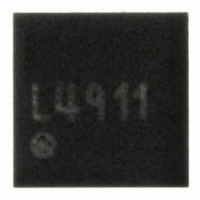LM4911LDX National Semiconductor, LM4911LDX Datasheet - Page 16

LM4911LDX
Manufacturer Part Number
LM4911LDX
Description
IC AMP AUDIO PWR .145W AB 10LLP
Manufacturer
National Semiconductor
Series
Boomer®r
Type
Class ABr
Datasheet
1.LM4911MMNOPB.pdf
(22 pages)
Specifications of LM4911LDX
Output Type
Headphones, 2-Channel (Stereo)
Max Output Power X Channels @ Load
145mW x 2 @ 16 Ohm
Voltage - Supply
2 V ~ 5.5 V
Features
Mute, Shutdown, Thermal Protection
Mounting Type
Surface Mount
Package / Case
10-LLP
Lead Free Status / RoHS Status
Lead free / RoHS Compliant
Available stocks
Company
Part Number
Manufacturer
Quantity
Price
Company:
Part Number:
LM4911LDX
Manufacturer:
NS
Quantity:
1 330
Part Number:
LM4911LDX
Manufacturer:
NS/国半
Quantity:
20 000
www.national.com
Application Information
AMPLIFIER CONFIGURATION EXPLANATION
As shown in Figure 1, the LM4911 has three operational am-
plifiers internally. Two of the amplifier's have externally con-
figurable gain while the other amplifier is internally fixed at the
bias point acting as a unity-gain buffer. The closed-loop gain
of the two configurable amplifiers is set by selecting the ratio
of R
is
By driving the loads through outputs V
acting as a buffered bias voltage the LM4911 does not require
output coupling capacitors. The classical single-ended am-
plifier configuration where one side of the load is connected
to ground requires large, expensive output coupling capaci-
tors.
A configuration such as the one used in the LM4911 has a
major advantage over single supply, single-ended amplifiers.
Since the outputs V
V
nates the need for output coupling capacitors which are re-
quired in a single-supply, single-ended amplifier configura-
tion. Without output coupling capacitors in a typical single-
supply, single-ended amplifier, the bias voltage is placed
across the load resulting in both increased internal IC power
dissipation and possible loudspeaker damage.
OUTPUT CAPACITOR vs. CAPACITOR COUPLED
The LM4911 is an stereo audio power amplifier capable of
operating in two distinct output modes: capacitor coupled (C-
CUPL) or output capacitor-less (OCL). The LM4911 may be
run in capacitor coupled mode by using a coupling capacitor
on each single-ended output (V
V
supply voltage to which the output amplifiers are typically bi-
ased and couples the audio signal to the headphones or other
single-ended (SE) load. The signal return to circuit ground is
through the headphone jack's sleeve.
The LM4911 can also eliminate these output coupling capac-
itors by running in OCL mode. Unless shorted to ground, VoC
is internally configured to apply a ½ V
stereo headphone jack's sleeve. This voltage matches the
bias voltage present on V
headphones. The headphones operate in a manner similar to
a bridge-tied load (BTL). Because the same DC voltage is
DD
o
C to ground. This output coupling capacitor blocks the half
, no net DC voltage exists across each load. This elimi-
f
to R
i
. Consequently, the gain for each channel of the IC
o
A, V
A
VD
o
o
B, and V
A and V
= -(R
o
f
A and V
/ R
o
o
i
B outputs that drive the
)
C are all biased at 1/2
o
DD
A and V
o
B) and connecting
bias voltage to a
o
B with V
o
C
16
applied to both headphone speaker terminals this results in
no net DC current flow through the speaker. AC current flows
through a headphone speaker as an audio signal's output
amplitude increases on the speaker's terminal.
The headphone jack's sleeve is not connected to circuit
ground when used in OCL mode. Using the headphone output
jack as a line-level output will place the LM4911's ½ V
voltage on a plug's sleeve connection. This presents no diffi-
culty when the external equipment uses capacitively coupled
inputs. For the very small minority of equipment that is DC
coupled, the LM4911 monitors the current supplied by the
amplifier that drives the headphone jack's sleeve. If this cur-
rent exceeds 500mA
the LM4911 and the external equipment.
MODE SELECT DETAIL
The LM4911 may be set up to operate in one of two modes:
OCL and cap-coupled. The default state of the LM4911 at
power up is cap-coupled. During initial power up or return from
shutdown, the LM4911 must detect the correct mode of op-
eration (OCL or cap-coupled) by sensing the status of the
V
(as seen on the Bypass pin), an internal comparator detects
the status of V
Ramp up of the bias voltage will proceed at a different rate
from this point on depending upon operating mode. OCL
mode will ramp up about 11 times faster than cap-coupled.
Shutdown is not a valid command during this time period
(T
reset (POR) signal. In addition, the slew rate of V
greater than 2.5V/ms to ensure reliable POR. Recommended
power up timing is shown in Figure 5 along with proper usage
of Shutdown and Mute. The mode select circuit is suspended
during C
The circuit shown in Figure 4 presents an applications solu-
tion to the problem of using different supply voltages with
different turn-on times in a system with the LM4911. This cir-
cuit shows the LM4911 with a 25-50kΩ pull-up resistor con-
nected from the shutdown pin to V
LM4911 is also being driven by an open drain output of an
external microcontroller on a separate supply. This circuit en-
sures that shutdown is disabled when powering up the
LM4911 by either allowing shutdown to be high before the
LM4911 powers on (the microcontroller powers up first) or al-
lows shutdown to ramp up with V
first). This will ensure the LM4911 powers up properly and
enters the correct mode of operation (cap-coupled or OCL).
O
WU
C pin. When the bias voltage of the part ramps up to 60mV
) and should not enabled to ensure a proper power on
B
discharge time.
O
C; and at 80mV, latches that value in place.
PK
, the amplifier is shutdown, protecting
DD
DD
. The shutdown pin of the
(the LM4911 powers up
DD
must be
DD
bias











